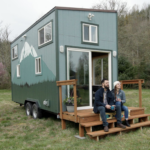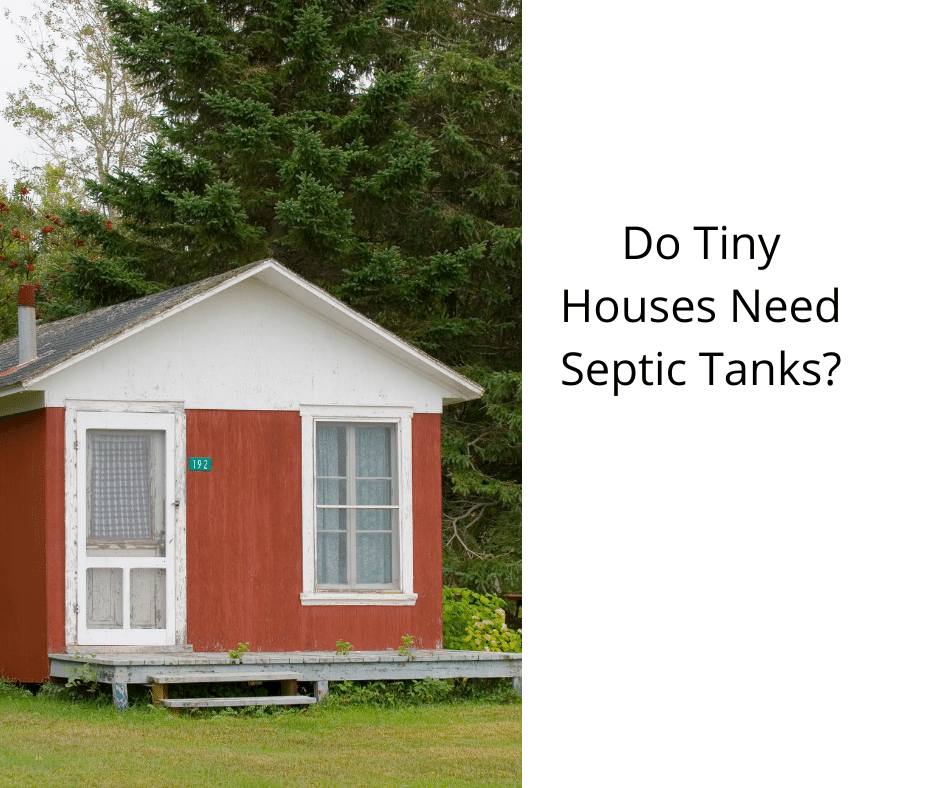Beginners Guides
How Deep Gravel Tiny House
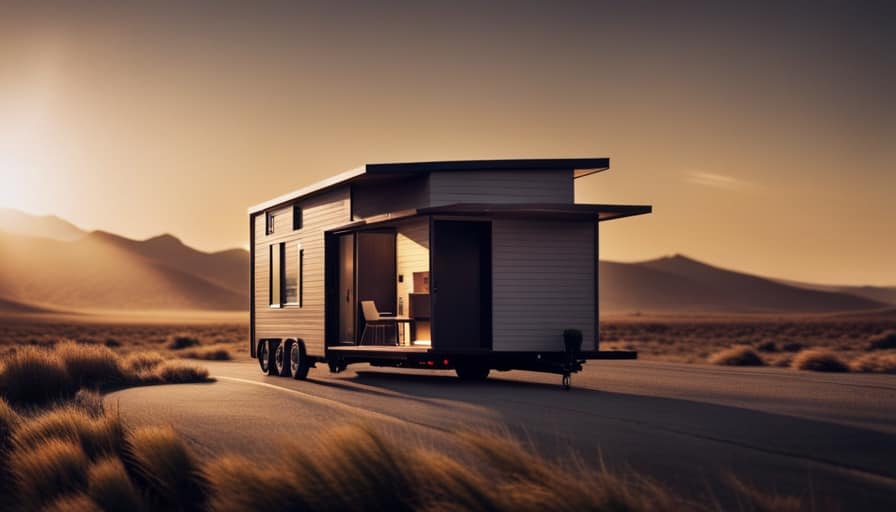
Being a fan of minimalism and eco-friendly living, I have come across the secret treasure of the deep gravel tiny house.
This unique dwelling not only offers a cozy and efficient living space, but also embraces the beauty of nature.
With its minimalistic design and eco-friendly features, the deep gravel tiny house is a true sanctuary.
Join me as I delve into the world of this extraordinary living concept and explore the countless benefits it has to offer.

Key Takeaways
- Deep gravel tiny houses offer a cozy and efficient living space that embraces the beauty of nature while featuring a minimalistic design.
- The cost of building a deep gravel tiny house ranges from $20,000 to $50,000, excluding land and permits, and finding suitable land can be challenging due to zoning regulations.
- Living in a deep gravel tiny house provides cost-effective living, encourages a decluttered and minimalist lifestyle, allows for a nomadic lifestyle, and promotes environmental sustainability.
- Designing the perfect deep gravel tiny house involves maximizing functionality and comfort, optimizing space, utilizing multifunctional furniture, and incorporating storage solutions that maximize vertical space.
The Deep Gravel Tiny House: An Introduction
As I begin to explore the concept of the Deep Gravel Tiny House, I’m fascinated by its unique design and potential.
The cost of building a Deep Gravel Tiny House can vary depending on factors such as size, materials used, and location. On average, it can range from $20,000 to $50,000. However, it’s important to note that this cost doesn’t include the land or any additional permits that may be required.
Speaking of permits, one of the challenges of zoning regulations for Deep Gravel Tiny Houses is that they’re often not specifically addressed in existing regulations. This can make it difficult to find suitable land or navigate the legal requirements.
It’s crucial to research local zoning laws and work with professionals who’ve experience in this area to ensure compliance and a smooth process.
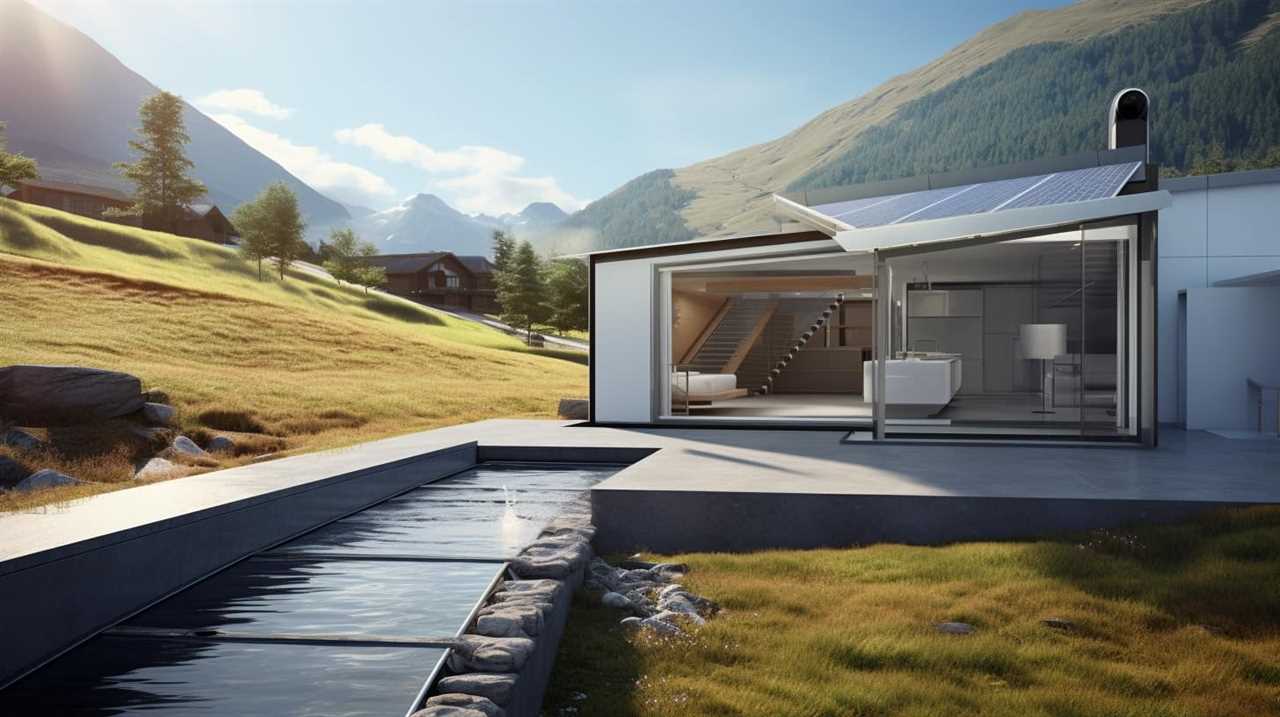
The Benefits of Living in a Deep Gravel Tiny House
For me, living in a Deep Gravel Tiny House offers a sense of freedom and simplicity. The advantages of this lifestyle are numerous. Firstly, the cost of living is significantly reduced. With a smaller space to heat, cool, and maintain, utility bills are minimized. Additionally, the compact size encourages a decluttered and minimalist lifestyle, allowing for a more organized and stress-free living environment. Secondly, the mobility of a tiny house on deep gravel allows for a nomadic lifestyle, giving the freedom to travel and explore new places while still having a cozy and comfortable home. Lastly, living in a deep gravel tiny house promotes environmental sustainability. The smaller footprint reduces energy consumption and encourages the use of eco-friendly materials. Overall, the deep gravel tiny house lifestyle offers a unique and fulfilling way of living, combining simplicity, freedom, and sustainability.
| Advantages | Lifestyle |
|---|---|
| Cost-effective | Decluttered and minimalist |
| Mobility | Nomadic lifestyle |
| Environmental sustainability | Cozy and comfortable home |
Designing the Perfect Deep Gravel Tiny House
One of the key considerations when designing the perfect deep gravel tiny house is to ensure that the space is maximized for functionality and comfort. Designing challenges in such a small space can be quite daunting, but with careful planning and creativity, it’s possible to create a space that feels spacious and efficient.
Space optimization is crucial in a deep gravel tiny house, as every square inch counts. Utilizing multifunctional furniture, such as a sofa that can be converted into a bed or a dining table that can be collapsed when not in use, is a great way to save space.
Additionally, incorporating storage solutions that maximize vertical space, such as wall-mounted shelves and cabinets, can help keep the living area clutter-free. By carefully considering the challenges of designing in a small space and prioritizing space optimization, the perfect deep gravel tiny house can be achieved.
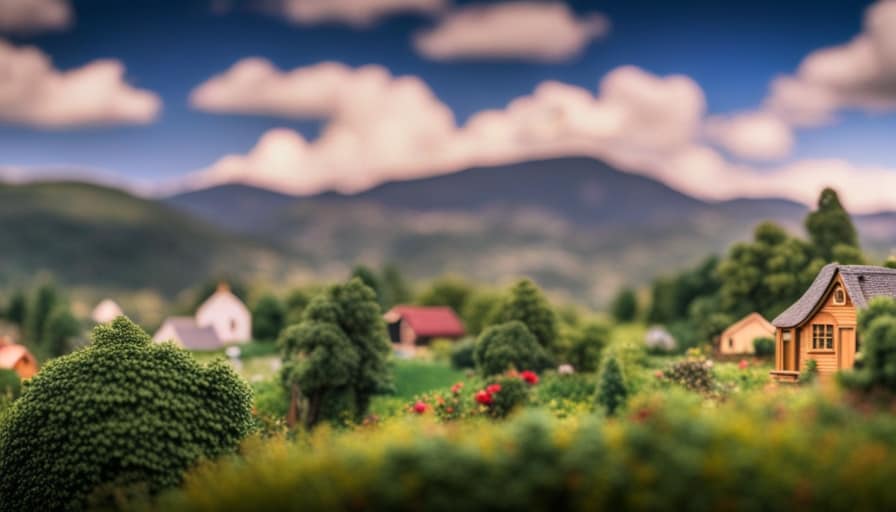
Sustainable Features of the Deep Gravel Tiny House
I love the sustainable features of my Deep Gravel Tiny House. One of the key aspects of its eco-friendliness is the use of environmentally friendly materials. From the renewable bamboo flooring to the reclaimed wood accents, every element of the house is chosen with sustainability in mind.
The energy-efficient design is another highlight. The house is equipped with solar panels that power the entire space, reducing reliance on non-renewable energy sources. Additionally, the well-insulated walls and energy-efficient appliances help minimize energy consumption.
These sustainable features not only reduce the environmental impact of the house but also contribute to a more comfortable and cost-effective living experience.
Now that you know about the sustainable features, let’s move on to some tips for making the most of your deep gravel tiny house space.
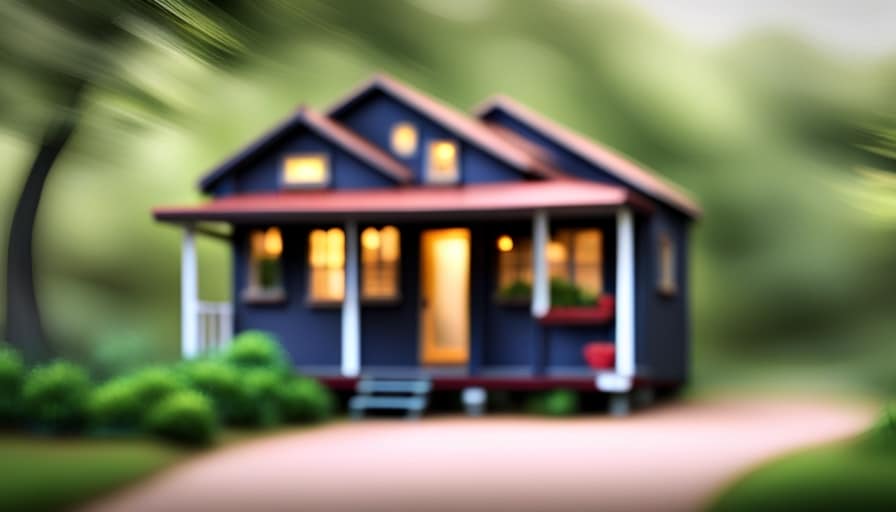
Tips for Making the Most of Your Deep Gravel Tiny House Space
To maximize your deep gravel tiny house space, utilize clever storage solutions and multifunctional furniture.
Maximizing storage is essential in a small living space like a deep gravel tiny house. Consider using vertical storage options such as shelves or hanging organizers to make the most of your walls. Utilize under-bed storage containers or drawers to keep your belongings organized and out of sight.
Another great way to maximize storage is by using furniture that serves multiple purposes. Look for sofas and chairs that can also be used as storage units, or tables that can be extended or folded down when not in use.
Frequently Asked Questions
What Are the Dimensions of a Deep Gravel Tiny House?
The dimensions of a deep gravel tiny house depend on the specific design and preferences of the builder. However, typical dimensions range from 8 to 30 feet in length and 8 to 12 feet in width.
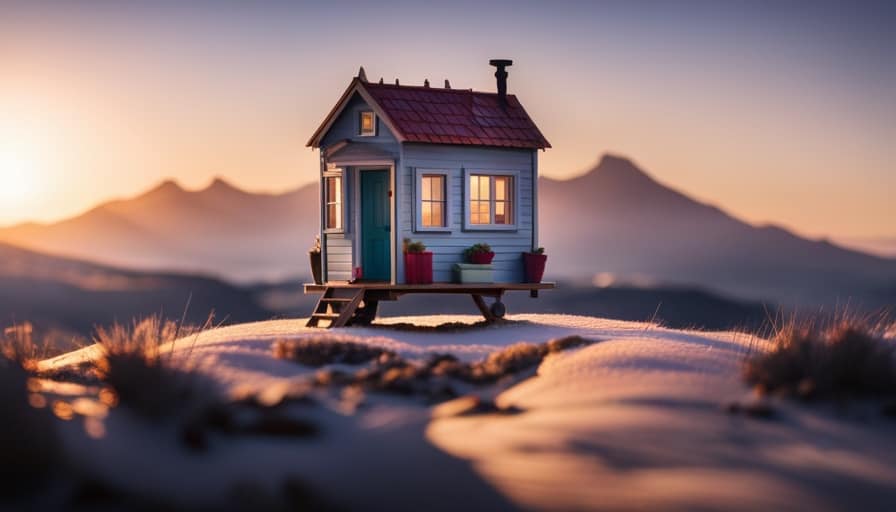
How Much Does It Cost to Build a Deep Gravel Tiny House?
Building a deep gravel tiny house can cost around $30,000 to $60,000, depending on various factors such as size, materials, and location. Construction typically takes several months, with careful planning and attention to detail ensuring a beautiful and functional home.
Can I Customize the Layout and Design of a Deep Gravel Tiny House?
Yes, you can customize the layout and design of a Deep Gravel Tiny House. There are various customization options available, allowing you to make interior design choices that suit your preferences and needs.
Is It Possible to Live in a Deep Gravel Tiny House off the Grid?
Living off grid in a deep gravel tiny house is definitely possible. With careful planning and sustainable practices, you can harness renewable energy sources, collect rainwater, and minimize your environmental impact while enjoying a simpler, self-sufficient lifestyle.
Are There Any Specific Permits or Regulations I Need to Consider When Building a Deep Gravel Tiny House?
When building a deep gravel tiny house, it’s essential to consider permit requirements and construction regulations. It’s important to research and comply with local regulations to ensure a safe and legal build.
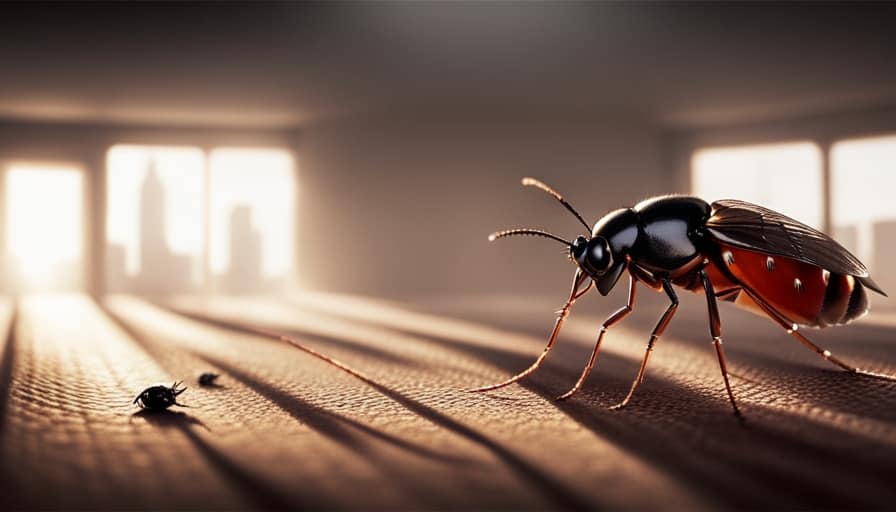
Conclusion
In conclusion, the Deep Gravel Tiny House offers a unique and sustainable living experience. With its innovative design and use of sustainable features, it provides a comfortable and eco-friendly living space.
Living in a Deep Gravel Tiny House allows you to minimize your environmental impact while still enjoying all the comforts of a traditional home.
So, why settle for ordinary when you can live in a Deep Gravel Tiny House and experience the extraordinary?
I’m Theodore, and I love tiny houses. In fact, I’m the author of Tiny House 43, a book about tiny houses that are also tree houses. I think they’re magical places where imaginations can run wild and adventures are just waiting to happen.
While tree houses are often associated with childhood, they can be the perfect adult retreat. They offer a cozy space to relax and unwind, surrounded by nature. And since they’re typically built on stilts or raised platforms, they offer stunning views that traditional homes simply can’t match.
If you’re looking for a unique and romantic getaway, a tree house tiny house might just be the perfect option.
Beginners Guides
Calculate How Much Solar Energy Needed To Charge Tiny House
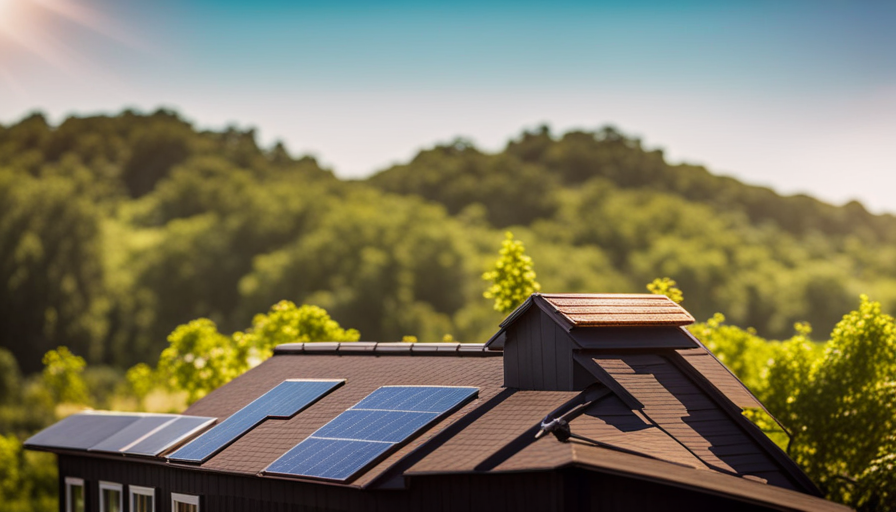
Picture a cozy, little house nestled in nature, far from the hustle and bustle of the city. Many enthusiasts of tiny houses, like me, envision this serene setting. Yet, to turn this dream into reality, one must consider practical aspects, such as how to supply **power** to the house. Want to know how to make it happen?
Solar energy is a fantastic option for tiny houses, providing a sustainable and efficient source of power. However, determining how much solar energy is needed to charge a tiny house can be a complex task. Factors such as energy consumption, location, climate, and battery storage capacity all come into play.
In this article, I will guide you through the process of calculating just how much solar energy you need to power your tiny house. So let’s dive in and uncover the secrets to achieving an off-grid, solar-powered life in your cozy abode.
Key Takeaways
- Factors such as energy consumption, location, climate, and battery storage capacity need to be considered when calculating the amount of solar energy needed to charge a tiny house.
- Assessing energy needs involves considering the appliances, electronics, and their power ratings.
- The location and climate impact the availability of sunlight for charging, with higher solar irradiance in certain areas being better for solar energy generation.
- The efficiency of solar panels, their placement, and the capacity of battery storage systems also play a role in determining the amount of solar energy needed.
Assess your energy needs
To accurately determine how much solar energy you’ll need to charge your tiny house, you must assess your energy needs and consider all the appliances and electronics you plan to use on a daily basis.
Start by assessing the solar potential of your location. Determine the amount of sunlight your area receives throughout the year, as this will directly impact the efficiency of your solar panels.
Additionally, estimating the energy efficiency of your appliances and electronics is crucial. Consider using energy-efficient models that consume less power.
By assessing your energy needs and considering these factors, you will have a better understanding of the solar energy required to charge your tiny house.
Moving forward, it’s important to determine your location and climate, which will further influence the solar energy needed for your tiny house.
Determine your location and climate
Based on your location and climate, you can determine the amount of sunlight available for charging your tiny house. Location selection plays a crucial role in maximizing solar energy production. Areas with higher solar irradiance receive more sunlight and are therefore better suited for solar energy generation.
Understanding the impact of climate on solar energy production is also important. Areas with frequent cloudy or overcast conditions may experience reduced solar energy output. Similarly, regions with long winters or shorter daylight hours may have limited sunlight available for charging.
By considering your location and climate, you can assess the feasibility of using solar energy to power your tiny house. Taking these factors into account will help you determine the potential solar energy capacity for your tiny house. This information will be useful when calculating your daily energy consumption needs.
Calculate your daily energy consumption
Determining your daily power usage is essential in understanding your energy needs for your tiny house. To calculate your monthly energy consumption, follow these steps:
- Start by making a list of all the appliances and electronics in your tiny house.
- Determine the power rating (in watts) of each item on your list. This information can usually be found on the appliance itself or in the user manual.
- Estimate the average number of hours each appliance is used per day.
- Multiply the power rating of each appliance by the number of hours it’s used to calculate the daily energy consumption for each item.
- Add up the daily energy consumption for all appliances to get your total daily power usage.
By knowing your daily energy consumption, you can accurately estimate the cost savings of solar energy for your tiny house. The next step is considering the energy efficiency of your appliances to optimize your solar power system.
Consider the energy efficiency of your appliances
Are your appliances energy efficient enough to power your tiny house without draining your solar resources? Can you imagine the impact of using energy-efficient appliances on your energy savings?
When it comes to calculating how much solar energy you need to charge your tiny house, the energy efficiency of your appliances plays a crucial role. Energy-efficient appliances consume less power, allowing you to maximize the use of your solar panel system. By investing in appliances with high energy efficiency ratings, you can significantly reduce the amount of solar energy required to power your tiny house. This not only saves you money in the long run but also ensures that your solar resources are not depleted quickly.
With energy-efficient appliances, you can make the most out of your solar panel efficiency and optimize your energy consumption. Transitioning into the subsequent section about determining the peak sun hours in your area, it is important to understand how solar panel efficiency varies throughout the day.
Determine the peak sun hours in your area
To fully utilize the potential of your solar panel system, it’s crucial to determine the peak sun hours in your area, allowing you to maximize the efficiency of your energy consumption. Peak sun hours refer to the period of the day when sunlight is strong enough to generate the maximum amount of solar energy. It varies depending on the season and geographical location. To get a better understanding, refer to the table below which illustrates the average peak sun hours for different seasons in a hypothetical location:
| Season | Average Peak Sun Hours |
|---|---|
| Spring | 5-6 hours |
| Summer | 7-8 hours |
| Fall | 4-5 hours |
Keep in mind that shading can significantly impact solar energy production. Obstructions such as tall buildings or trees can cast shadows on your solar panels, reducing their efficiency. Understanding peak sun hours and shading will help you determine the most suitable placement for your solar panels. This knowledge will be essential as we move forward to calculate the size of your solar panel system and meet your tiny house’s energy needs.
Calculate the size of your solar panel system
Once you know the peak sun hours in your area and understand how shading can affect solar energy production, it’s time to figure out the ideal size of your solar panel system to power your cozy little home.
To calculate the size of your solar panel system, you need to consider the solar panel efficiency. This refers to the ability of the panels to convert sunlight into electricity. Higher efficiency panels will require fewer panels to generate the same amount of power.
Additionally, you should estimate the installation costs for your solar panel system. This includes the cost of the panels, inverters, mounting equipment, and labor. By considering both the solar panel efficiency and installation costs, you can determine the optimal size of your system.
Once you have this information, you can factor in battery storage capacity to ensure a consistent supply of power for your tiny house.
Factor in battery storage capacity
Factor in battery storage capacity to ensure a consistent and reliable power supply for your cozy home. When calculating the size of your solar panel system, it’s crucial to consider the battery storage capacity that will meet your energy needs. Here are three important aspects to consider when factoring in battery storage capacity:
- Installation options: Determine the type of battery that suits your tiny house. Lithium-ion batteries are popular due to their high energy density and longer lifespan. However, they can be more expensive compared to lead-acid batteries.
- Maintenance requirements: Regular maintenance is essential to maximize the lifespan and efficiency of your battery storage system. This includes monitoring the battery charge levels, checking for any signs of damage or corrosion, and ensuring proper ventilation.
- Cost considerations: Battery storage systems can add to the overall cost of your solar panel setup. It’s important to weigh the upfront cost against the long-term benefits and energy savings.
Now, let’s delve into the next section and explore backup power options to further enhance your energy independence.
Consider backup power options
When thinking about ensuring a reliable and uninterrupted power supply for your cozy home, it’s worth exploring the options available for backup power.
Backup power sources are essential for off-grid living, providing a reliable source of electricity when the sun is not shining or when there is a power outage.
There are various backup power options to consider, such as generators, battery banks, and even connecting to the grid as a backup.
Generators can provide immediate power but are often noisy and require fuel.
Battery banks, on the other hand, store excess solar energy for later use and can be a quiet and clean backup option.
It’s important to consult with a solar energy professional to determine the best backup power solution for your specific needs and to ensure a seamless transition into the subsequent section about consulting with them.
Consult with a solar energy professional
To truly maximize the potential of your cozy home’s power supply, it’s essential to consult with a solar energy professional who can provide expert guidance and tailor a backup power solution to meet your specific needs.
When exploring alternative energy sources for your tiny house, solar power emerges as a cost-effective option. However, determining the exact solar energy needed to charge your tiny house requires careful evaluation. By consulting with a solar energy professional, you can gain insights into the specific requirements of your home and calculate the optimal solar energy capacity needed.
During the consultation, the professional will assess factors such as your energy consumption, available roof space, and sun exposure. They will also consider any additional backup power options that may be necessary to ensure uninterrupted energy supply. Once armed with this information, you can make informed decisions and move forward with confidence.
Transition: Now that we have determined the solar energy requirements for your tiny house, let’s move on to monitoring and adjusting your energy usage.
Monitor and adjust your energy usage
After consulting with a solar energy professional to ensure the most efficient solar panel installation for my tiny house, I’ve now moved on to the next step: monitoring and adjusting my energy usage. This is crucial in order to accurately calculate how much solar energy is needed to charge my tiny house.
By implementing energy-saving tips, such as using energy-efficient appliances and LED lighting, I can significantly reduce my energy consumption. Additionally, I can monitor my energy usage through smart home technology and make adjustments accordingly. This includes turning off unused devices, optimizing heating and cooling settings, and being mindful of water usage.
By actively managing my energy usage, I can ensure that my solar panels are generating enough energy to power my tiny house efficiently and sustainably.
Frequently Asked Questions
How much does a tiny house typically consume in energy on a daily basis?
On a daily basis, a typical tiny house consumes a surprisingly large amount of energy. Understanding its energy consumption patterns is crucial in exploring renewable energy alternatives, such as solar power, to meet its needs efficiently.
What are some energy-efficient appliances that can be used in a tiny house?
Energy efficient appliances are essential for sustainable living in a tiny house. They help minimize energy consumption and maximize efficiency. Some examples include LED lights, low-flow water fixtures, energy star-rated appliances, and smart thermostats.
Are there any backup power options available for a solar-powered tiny house?
Solar-powered tiny houses can have backup power options through solar battery storage. These batteries store excess energy generated by the solar panels, providing a reliable power source during cloudy days or at night.
How long do solar panels typically last before needing to be replaced?
Solar panel lifespan varies depending on several factors, including quality, maintenance, and environmental conditions. On average, solar panels last around 25 to 30 years before needing to be replaced.
How much does it cost to install a solar panel system for a tiny house?
Installing a solar panel system for a tiny house involves several cost factors, such as the size of the system, quality of equipment, and labor fees. The installation process includes mounting panels, connecting components, and ensuring proper electrical connections.
Conclusion
After assessing my energy needs and considering my location and climate, I was able to calculate the daily energy consumption for my tiny house. By factoring in the energy efficiency of my appliances and the peak sun hours in my area, I now have a clear understanding of how much solar energy is needed to power my home.
In addition to that, I have also considered the battery storage capacity and explored backup power options. I consulted with a solar energy professional to ensure optimal efficiency.
Moving forward, I will monitor and adjust my energy usage accordingly.
I’m Theodore, and I love tiny houses. In fact, I’m the author of Tiny House 43, a book about tiny houses that are also tree houses. I think they’re magical places where imaginations can run wild and adventures are just waiting to happen.
While tree houses are often associated with childhood, they can be the perfect adult retreat. They offer a cozy space to relax and unwind, surrounded by nature. And since they’re typically built on stilts or raised platforms, they offer stunning views that traditional homes simply can’t match.
If you’re looking for a unique and romantic getaway, a tree house tiny house might just be the perfect option.
Beginners Guides
Buy A Tiny House And Legalize It As ADU How To
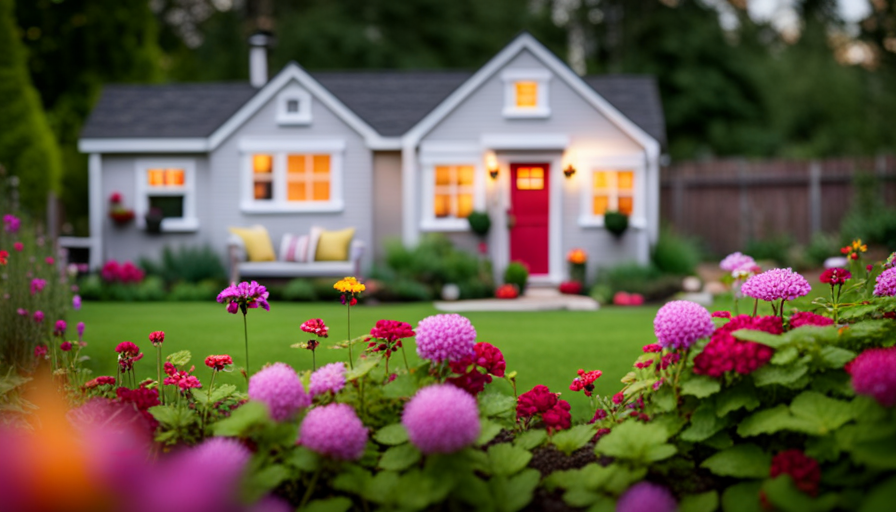
Have you ever dreamt of living in a cozy, environmentally-friendly home that suits your minimalist lifestyle? Imagine a place where every inch is purposefully and efficiently utilized. A place that not only saves you money but also contributes to a more sustainable future. Welcome to the world of tiny houses.
In this article, I will guide you through the process of buying a tiny house and legalizing it as an Accessory Dwelling Unit (ADU). ADUs are becoming increasingly popular as a way to create additional living space on your property, whether it’s for family members, rental income, or simply to downsize.
But before you take the plunge, it’s important to understand the benefits of living in a tiny house, as well as the regulations and requirements for legalizing it as an ADU. From researching local zoning and building codes to consulting with local authorities, designing and building to code, and overcoming potential challenges, I’ll provide you with all the information you need to make your tiny house dream a reality.
So, let’s dive in and explore the world of tiny houses and ADUs together!
Key Takeaways
- Understanding local zoning and building codes is crucial for legalizing a tiny house as an ADU.
- Researching local financing options can provide grants, loans, or tax incentives for ADU construction.
- Connecting utilities and services in a tiny house requires professional contractors and brings convenience to daily life.
- Overcoming potential challenges, such as finding suitable locations and complying with neighborhood requirements, is necessary when legalizing a tiny house as an ADU.
Benefits of Living in a Tiny House
You’ll love the incredible benefits of living in a tiny house! Not only do these compact homes offer a unique and minimalist lifestyle, but they also provide significant cost savings and promote eco-friendly living.
One of the most attractive aspects of tiny house living is the affordability. With lower construction and maintenance costs, you can save a substantial amount of money. Additionally, tiny houses are designed to be energy-efficient, using less electricity and water, which further reduces expenses.
Living in a tiny house also allows you to minimize your carbon footprint. These compact homes require fewer resources to build and maintain, making them a greener housing option.
Understanding accessory dwelling units (ADUs) is the next step towards legalizing your tiny house as an ADU and unlocking even more benefits.
Understanding Accessory Dwelling Units (ADUs)
Discovering the ins and outs of ADUs can open up a world of possibilities for expanding your living space. Understanding zoning regulations is crucial when it comes to legalizing your tiny house as an ADU.
Each city has its own rules and restrictions regarding ADUs, so it’s important to familiarize yourself with the specific regulations in your area. This includes requirements for minimum lot size, setback distances, and parking.
Additionally, researching local financing options is essential. Some cities offer grants or low-interest loans specifically for ADU construction or conversion. Others may have programs that provide tax incentives or subsidies. By understanding these financing options, you can make informed decisions about how to fund your ADU project.
Transitioning into the subsequent section about researching local zoning and building codes, it’s vital to have a clear understanding of the regulations in order to ensure compliance and avoid any legal issues.
Researching Local Zoning and Building Codes
Exploring your area’s zoning and building codes is crucial to ensure compliance and avoid any legal complications when it comes to expanding your living space. Conducting thorough local zoning research and building code analysis will provide you with the necessary information to make informed decisions about your tiny house as an accessory dwelling unit (ADU). It is important to understand the specific regulations and requirements set by your local government, as they can vary significantly from one area to another. Some key factors to consider include setbacks, height restrictions, minimum lot size, and parking requirements. To visualize this process, refer to the table below:
Zoning Regulations Building Codes Setbacks Construction Type Height Restrictions Safety Standards Minimum Lot Size Electrical Wiring Parking Requirements Plumbing Systems
By thoroughly researching and understanding your local zoning and building codes, you will be better equipped to navigate the process of legalizing your tiny house as an ADU. This knowledge will also facilitate your consultation with local authorities to ensure compliance and gain the necessary approvals.
Consultation with Local Authorities
When it comes to legalizing a tiny house as an accessory dwelling unit (ADU), it’s crucial to have a consultation with local authorities. Meeting with city planners allows for a thorough understanding of the specific zoning and building codes that need to be followed.
Additionally, obtaining the necessary permits is essential to ensure compliance with all regulations and to avoid any legal issues in the future.
Meeting with City Planners
Before meeting with city planners, make sure to thoroughly research the regulations and zoning requirements for tiny houses in your area, as this will demonstrate your commitment and preparedness during the discussion.
City planner consultation is crucial in understanding the specific guidelines and restrictions that apply to your situation. Familiarize yourself with the zoning regulations, setback requirements, and any other relevant ordinances that may affect the legality of your tiny house as an accessory dwelling unit (ADU).
Additionally, gather information on the application process and any necessary documentation required by the city planners. By doing so, you can address any concerns or questions they may have and present a well-informed case for legalizing your tiny house as an ADU.
Once you have a clear understanding of the regulations, you can move forward with obtaining necessary permits to make your tiny house compliant with local laws and regulations.
Obtaining Necessary Permits
Acquiring the requisite documentation and permits is essential for ensuring compliance with local regulations and moving forward with the construction of a legally approved tiny home. Navigating the legal requirements can be a complex process, but with careful planning and attention to detail, it’s achievable.
The first step is to research and identify the specific permits needed for your tiny house project. This may include building permits, zoning permits, and electrical permits, among others. Contacting the local building department or planning office is crucial to understand the requirements and procedures. They can provide guidance on the necessary paperwork, fees, and inspections.
It’s important to follow the guidelines precisely to avoid potential delays or fines. Once the necessary permits are obtained, you can proceed to the next phase of designing and building a tiny house to code, ensuring your project meets all the necessary safety and construction standards.
Designing and Building a Tiny House to Code
Designing and building a tiny house to code allows you to create a cozy and functional space that not only meets regulations but also fills your heart with excitement and pride.
When considering the design, it’s important to take into account the designing constraints imposed by your local building department. This may include limitations on the height, size, or placement of your tiny house.
Additionally, incorporating eco-friendly materials not only helps the environment but can also be cost-effective in the long run. Consider using sustainable materials such as reclaimed wood, recycled insulation, and energy-efficient appliances.
Paying attention to every detail during the construction process is crucial to ensure that your tiny house complies with all building codes.
By designing and building your tiny house to code, you can move on to the next step of connecting utilities and services seamlessly.
Connecting Utilities and Services
After designing and building a tiny house to code, the next step is connecting utilities and services. This involves finding contractors who can install the necessary connections for electricity, water, and sewage. It’s important to work with professionals who have experience in working with tiny houses and can ensure that the connections are made safely and efficiently.
To help you visualize the process, here is a table that highlights the emotional benefits of having utilities and services connected to your tiny house:
Emotional Benefits Connecting Utilities and Services Convenience Having all the necessary utilities readily available in your tiny house brings convenience to your daily life. Comfort A well-connected tiny house allows you to enjoy the comforts of home, such as running water and electricity. Independence Being able to connect to utilities and services gives you the freedom to live independently, without relying on others. Peace of Mind Knowing that your tiny house is properly connected to utilities and services provides peace of mind and a sense of security.
With utilities and services connected, the next section will focus on ensuring safety and security in your tiny house.
Ensuring Safety and Security
Once you’ve got all your utilities and services connected, it’s time to ensure the safety and security of your cozy little haven. Here are some important steps to take in order to guarantee the well-being of your tiny house as you go through the process of legalizing it as an ADU:
- Install a reliable security system to protect your tiny house from potential intruders.
- Consider adding fire alarms and carbon monoxide detectors to ensure the safety of you and your loved ones.
- Implement proper lighting both inside and outside your tiny house to prevent accidents and deter any unwanted visitors.
- Secure your windows and doors with sturdy locks and reinforce them if necessary.
Ensuring the safety and security of your tiny house is crucial before moving forward with the process of applying for ADU legalization. By taking these precautions, you can have peace of mind knowing that your cozy abode is safe and protected.
Now, let’s delve into the next section about applying for ADU legalization.
Applying for ADU Legalization
When it comes to making your tiny haven officially recognized as an ADU, getting the process of applying for legalization can be an exciting and rewarding journey. The applying process for ADU legalization involves several steps and documentation requirements. To help you navigate through this process smoothly, here is a breakdown of the key steps and documents you will need:
Step Description 1 Research local regulations and requirements for ADU legalization. 2 Prepare architectural plans and site layout for your tiny house. 3 Submit a completed application form along with the necessary documents, such as proof of ownership and utility connections. 4 Pay any required fees and wait for the application to be reviewed. 5 Schedule an inspection to ensure compliance with safety and building codes.
By following these steps and providing the required documentation, you can increase your chances of successfully legalizing your tiny house as an ADU. However, the process may still have potential challenges that you need to overcome, which will be discussed in the next section.
Overcoming Potential Challenges
Navigating the application process for ADU legalization can present some obstacles, but fear not, there are ways to overcome these challenges and turn your tiny haven into an officially recognized home.
One of the potential obstacles you may encounter is finding suitable locations for your tiny house. Depending on local regulations, you might face restrictions on where ADUs are allowed. Researching zoning laws and consulting with local authorities can help you identify areas where you can legally place your tiny house.
Additionally, some neighborhoods or communities may have specific requirements or design guidelines for ADUs, so it’s important to familiarize yourself with these before starting the application process.
By doing thorough research and being proactive in addressing any potential obstacles, you can increase your chances of successfully legalizing your tiny house as an ADU. This will allow you to enjoy the benefits of an affordable and sustainable home without compromising on comfort or style.
Enjoying the Benefits of an Affordable and Sustainable Home
Embracing the perks of an affordable and eco-friendly dwelling is like discovering a hidden treasure trove of savings and sustainability. When you buy a tiny house and legalize it as an ADU, you open the door to a world of benefits.
One of the most significant advantages is the affordability factor. Tiny houses are a cost-effective housing solution, offering a lower mortgage or rental payment compared to traditional homes. This financial freedom allows for more flexibility and a reduced financial burden.
Additionally, tiny houses are designed with environmental sustainability in mind. They often utilize eco-friendly materials, energy-efficient appliances, and renewable energy sources. By living in a tiny house, you actively contribute to reducing your carbon footprint and promoting a greener lifestyle. It’s a win-win situation, where you can enjoy the comforts of home while making a positive impact on the environment.
Frequently Asked Questions
Can I legally live in a tiny house on any piece of land?
I’m not an expert, but from my understanding, living in a tiny house on any piece of land may not be legal. Zoning regulations vary, and you should research local laws regarding tiny house zoning and the process of legalizing tiny homes.
How long does the process of legalizing an ADU typically take?
The average timeline for legalizing an ADU can vary depending on local regulations and challenges. Common challenges include obtaining permits, meeting building codes, and navigating zoning restrictions.
Are there any restrictions on the size or height of a tiny house that can be legalized as an ADU?
There are size and height restrictions when legalizing a tiny house as an ADU. The specific limitations may vary depending on local regulations, but they typically exist to ensure the structure meets safety and zoning requirements.
What are the potential penalties or consequences if I live in a tiny house without legalizing it as an ADU?
Living in a tiny house without legalizing it as an ADU can result in potential penalties such as fines and eviction. It may also impact property value and pose challenges of living off-grid.
Are there any financial assistance programs available to help with the costs of legalizing a tiny house as an ADU?
Financial assistance programs may be available to help with the costs of legalizing a tiny house as an ADU. Eligibility requirements and potential funding sources vary, and the application process typically involves providing documentation and demonstrating financial need.
Conclusion
In conclusion, opting for a tiny house and legalizing it as an ADU offers a plethora of benefits. Living in a compact yet functional space not only promotes a minimalist lifestyle but also helps reduce carbon footprint.
By adhering to local zoning and building codes, consulting with authorities, and designing a safe and secure structure, one can successfully navigate the process of legalizing their tiny house. Overcoming potential challenges along the way, homeowners can ultimately enjoy the advantages of an affordable and sustainable home.
The coincidence of affordability and sustainability makes this option all the more appealing for those seeking a unique and eco-friendly living experience.
I’m Theodore, and I love tiny houses. In fact, I’m the author of Tiny House 43, a book about tiny houses that are also tree houses. I think they’re magical places where imaginations can run wild and adventures are just waiting to happen.
While tree houses are often associated with childhood, they can be the perfect adult retreat. They offer a cozy space to relax and unwind, surrounded by nature. And since they’re typically built on stilts or raised platforms, they offer stunning views that traditional homes simply can’t match.
If you’re looking for a unique and romantic getaway, a tree house tiny house might just be the perfect option.
Beginners Guides
How Do I Buy A Tiny House
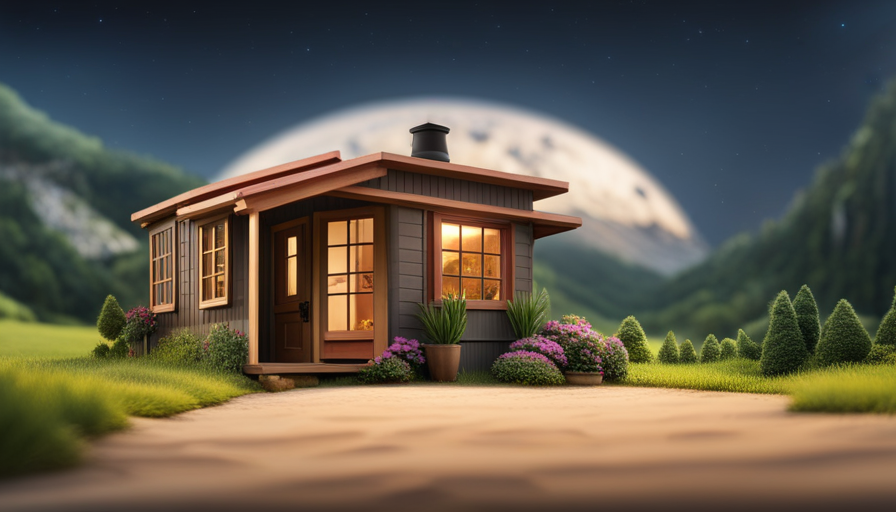
Are you thinking about buying a small home? Imagine stepping into a world where simplicity is valued, focusing on keeping things simple, and embracing a minimalist lifestyle. It’s a place where you can live comfortably while also reducing your environmental footprint and saving money.
But how do you make this dream a reality? In this article, I will guide you through the process of buying a tiny house, from researching different models to securing financing and arranging for delivery. Whether you’re looking for a cozy retreat in the mountains or a mobile home to explore the open road, I’ve got you covered.
So, let’s dive in and discover how to navigate the world of tiny houses and find the perfect home that fits your needs and budget. Get ready to embark on a journey towards a simpler, more fulfilling life.
Key Takeaways
- Research different tiny house models and compare their size, layout, materials, and customization options.
- Determine your budget and explore financing options such as personal loans, RV loans, or crowdfunding.
- Find a reputable tiny house builder or dealer through research and customer reviews, and visit showrooms and model homes to assess craftsmanship and design.
- Familiarize yourself with zoning regulations and building codes for tiny house placement, and assess the location for accessibility, amenities, and zoning restrictions.
Research Different Tiny House Models
If you’re ready to embark on your tiny house journey, it’s time to start researching and exploring the vast array of unique and innovative tiny house models available. Researching features and comparing prices is an essential step in finding the perfect tiny house that meets your needs and fits your budget.
There are numerous online platforms, blogs, and forums dedicated to tiny house enthusiasts where you can gather valuable information and insights. Take the time to thoroughly research different models, considering factors such as size, layout, materials, and customization options. Look for features that are important to you, whether it’s a loft bedroom, a solar power system, or eco-friendly construction materials.
As you compare prices, keep in mind that the cost of a tiny house can vary greatly depending on its size, design, and location. Once you have a good understanding of the different models available and their price ranges, you can move on to the next step: determining your budget and financing options.
Determine Your Budget and Financing Options
Once you’ve crunched the numbers and explored various ways to secure funds, you’ll be ready to embark on your journey towards making a cozy abode yours.
Determining your budget is a crucial step in the process of buying a tiny house. Start by evaluating your finances and setting a realistic budget that considers not only the cost of the tiny house itself but also any additional expenses such as land, utilities, and maintenance. Take into account your income, savings, and any potential financing options that may be available to you.
When it comes to financing options, there are several routes you can explore. Traditional mortgages may not be suitable for tiny houses due to their small size and unconventional nature. However, you can consider personal loans, RV loans, or even crowdfunding as alternative financing options. Each option has its own pros and cons, so it’s important to do thorough research and compare interest rates, repayment terms, and eligibility requirements.
Once you have determined your budget and explored your financing options, it’s time to find a reputable tiny house builder or dealer. This step is crucial to ensure that you’re getting a quality-built tiny house that meets your needs and preferences.
Find a Reputable Tiny House Builder or Dealer
After determining your budget and exploring financing options, it’s time to seek out a trusted builder or dealer for your cozy abode. Finding a reputable tiny house builder or dealer is crucial to ensure that you get a quality and well-built tiny house that meets your needs.
Here are three essential steps to help you find the right builder or dealer for your tiny house:
- Research Tiny House Builders Directory: Start by exploring the Tiny House Builders Directory, which is a comprehensive listing of reputable builders across the country. This directory provides valuable information about each builder, including their experience, portfolio, and customer reviews. Take the time to read through the reviews to get a sense of the builder’s professionalism and customer satisfaction.
- Read Tiny House Dealer Reviews: If you prefer to purchase a pre-built tiny house from a dealer, read reviews about different dealers in your area. Look for dealers with positive reviews, excellent customer service, and a wide selection of tiny houses to choose from. Reading reviews can give you insights into the dealer’s reputation and the quality of their products.
- Visit Showrooms and Model Homes: Once you have narrowed down your choices, visit showrooms and model homes to get a firsthand look at the builder’s craftsmanship. Pay attention to the details, such as the quality of materials used, the layout, and the overall design. This will help you determine if the builder’s style aligns with your preferences.
Now that you’ve found a reputable builder or dealer, it’s time to consider your space and design needs for your dream tiny house.
Consider Your Space and Design Needs
Now that you have found a reputable builder or dealer, it’s time to delve into the exciting realm of envisioning the perfect layout and design for your future compact haven. When it comes to tiny house living, space is at a premium. Therefore, it is essential to consider your space and design needs carefully. To help you visualize the possibilities, I have created a table below with three columns and five rows showcasing space-saving furniture and interior design ideas.
Column 1 Column 2 Column 3 Loft bed with storage Convertible dining table Wall-mounted folding desk Multi-functional sofa bed Pull-out kitchen cabinets Staircase with built-in drawers Wall-mounted folding table Murphy bed with built-in shelves Floating shelves Nesting tables Hidden storage ottoman Sliding pantry shelves Foldable chairs Under-stair storage Floating desk
As you can see, there are numerous options for maximizing space while still maintaining a stylish and functional living environment. By incorporating these space-saving furniture and interior design ideas, you can create a tiny house that meets all your needs and desires.
Now that you have considered your space and design needs, it’s time to evaluate the location and zoning regulations to ensure your tiny house dream becomes a reality.
Evaluate the Location and Zoning Regulations
Finding the perfect location and navigating through zoning regulations can be a thrilling yet challenging journey towards turning your tiny house dream into a reality. When evaluating the local community, it’s important to consider factors such as accessibility to amenities, proximity to work or school, and the overall vibe of the neighborhood.
Additionally, it’s crucial to research and understand the zoning regulations in the area where you plan to place your tiny house. Some areas may have specific rules regarding the size, height, and even the materials used in construction. Familiarizing yourself with these regulations can save you from potential legal issues in the future.
As you evaluate the location and zoning regulations, it’s also essential to consider the building codes in the area. Building codes ensure safety and structural integrity, and it’s crucial to comply with them when constructing your tiny house. This may involve obtaining necessary permits and inspections to ensure your tiny house meets the required standards.
Finding the perfect location for your tiny house and understanding the zoning regulations and building codes are essential steps in the journey towards purchasing a tiny house. Once you’ve evaluated the location and familiarized yourself with the regulations, the next step is to inspect and assess the quality of construction.
Inspect and Assess the Quality of Construction
Take a close look at the craftsmanship and construction of your potential abode, ensuring that every nook and cranny reflects the meticulous attention to detail you desire. It is essential to inspect and assess the quality of materials used in the construction of the tiny house. Look for signs of durability and longevity, such as solid wood framing, high-quality insulation, and sturdy roofing materials. Comparing different construction methods can help you understand the pros and cons of each, whether it’s traditional stick-built construction, modular construction, or even shipping container conversion.
To assist you in evaluating the quality of construction, consider using the following table:
| Construction Method | Pros | Cons |
|---|---|---|
| Stick-Built | – Customizable |
- Traditional look
- Can be more affordable | – Longer construction time
- Higher risk of weather-related damage | | Modular | – Quick construction time
- Can be relocated
- Built-in quality control | – Limited customization options
- Higher upfront cost
- May require permits for relocation | | Shipping Container | – Eco-friendly
- Portable
- Lower construction cost | – Limited space
- May require modification for livability
- May face zoning restrictions |
By thoroughly inspecting the construction quality and comparing different methods, you can make an informed decision about your tiny house purchase. After evaluating the construction, it’s time to negotiate the purchase price and terms, ensuring you get the best deal possible.
Negotiate the Purchase Price and Terms
Make sure you thoroughly discuss and negotiate the purchase price and terms of your potential abode, utilizing your knowledge of the construction quality and various methods to secure the best deal possible for your future home.
Negotiation strategies can greatly impact the final price you pay for your tiny house. It’s important to do your research and gather information about comparable properties in the area to have a better understanding of the market value. Additionally, consider the factors affecting the purchase price such as the size, materials used, location, and any additional features or upgrades. By highlighting any flaws or areas that may need improvement, you can negotiate a lower price.
Don’t be afraid to make counteroffers and be prepared to walk away if the seller is not willing to meet your terms. Remember, negotiation is a give-and-take process, so be flexible but also firm on your desired outcome.
With the purchase price and terms settled, you can now move on to securing financing or choosing a suitable payment method for your tiny house, ensuring a smooth transition into the next step.
Secure Financing or Payment Method
After successfully negotiating the purchase price and terms of your dream tiny house, it’s time to move on to the next crucial step: securing financing or determining the payment method.
When it comes to financing options for a tiny house, you have a few choices to consider. One option is to approach traditional lenders, such as banks or credit unions, to apply for a loan specifically tailored for tiny houses. These loans often come with favorable interest rates and terms, making them a popular choice among buyers.
Another financing option is to explore personal loans, which can be obtained through online lenders or even peer-to-peer lending platforms. These loans offer flexibility and can be used for various purposes, including purchasing a tiny house.
Additionally, if you have saved up enough money, you may opt for an outright cash purchase, eliminating the need for financing altogether.
Whatever route you choose, it’s essential to carefully assess your financial situation and choose the option that best suits your needs.
Now that you’ve secured your financing or determined your payment method, it’s time to move on to the exciting part: arranging for delivery and set-up of your new tiny house.
Arrange for Delivery and Set-Up
Now that you’ve secured financing or determined your payment method, it’s time to get excited about arranging the delivery and set-up of your brand new compact dwelling.
When it comes to delivery options, you have a few choices to consider. Some tiny house companies offer delivery services as part of their package, while others may require you to arrange for transportation yourself. It’s important to inquire about their delivery policies and any additional costs involved.
Once you’ve sorted out the logistics of delivery, the set-up process can begin. The first step is to prepare the site where your tiny house will be placed. This involves ensuring that the area is level and accessible for the delivery truck. Depending on the size of your tiny house, you may need to obtain any necessary permits or permissions from your local municipality.
Next, the delivery team will carefully unload your tiny house from the truck and position it in the designated spot. They will then connect the utilities, such as water and electricity, to ensure that everything is in working order. Finally, they will make any necessary adjustments and ensure that your tiny house is secure and ready for you to move in.
With the delivery and set-up complete, you can now transition into the next phase of your journey – enjoying your new minimalist lifestyle.
Enjoy Your New Minimalist Lifestyle
Embracing the simplicity of my compact dwelling, I can fully immerse myself in the freedom and contentment that comes with a minimalist lifestyle. Living in a tiny house has numerous benefits for those seeking a simpler way of life.
One of the main advantages is the ability to downsize and reduce clutter. With limited space, I’m forced to evaluate and prioritize my possessions, keeping only the essentials. This process not only saves me money but also eliminates the stress and burden of excessive material possessions.
Minimalist living also allows me to focus on experiences rather than things. With less time spent on cleaning and maintaining a large home, I can devote more energy to pursuing my passions and spending quality time with loved ones. Additionally, the reduced financial burden of a tiny house frees up resources for travel and other enriching activities.
To fully enjoy my new minimalist lifestyle, I’ve found a few downsizing tips to be invaluable. First, it’s important to let go of sentimental attachments and only keep items that serve a practical purpose. Secondly, organizing and decluttering regularly helps to maintain a sense of order and simplicity. Lastly, embracing the concept of ‘one in, one out’ ensures that I don’t accumulate unnecessary items over time.
Living in a tiny house offers the opportunity to fully embrace a minimalist lifestyle. The benefits of downsizing and simplifying one’s life are numerous, from reducing clutter and stress to focusing on experiences rather than material possessions. By following some downsizing tips, I can fully enjoy the freedom and contentment that comes with living in a compact dwelling.
Frequently Asked Questions
What are the maintenance and upkeep costs associated with owning a tiny house?
Maintenance costs and upkeep expenses for a tiny house can vary depending on factors like location, materials used, and personal preferences. Regular cleaning, repairs, and utilities are typical expenses, but the joy of owning a cozy, cost-effective home outweighs these minor monetary commitments.
Are there any restrictions or regulations on where I can park my tiny house?
There are parking restrictions and zoning regulations that may limit where you can park your tiny house. It’s important to research and understand local laws and regulations before purchasing a tiny house to ensure you can legally park it.
Can I customize the design and layout of the tiny house?
You’ll be amazed at the customization options available for your tiny house. From layout to design, the possibilities are endless. However, keep in mind that there may be some design limitations to consider.
Are there any insurance requirements for a tiny house?
There are insurance requirements for tiny houses, and it’s important to have coverage. Common insurance options include liability, property damage, and theft coverage. It’s crucial to protect your investment and ensure peace of mind.
Are there any hidden costs or additional fees I should be aware of when buying a tiny house?
When buying a tiny house, it’s important to be aware of potential additional expenses and hidden fees. These can include land rental fees, utility hook-ups, permits, and maintenance costs. Being prepared for these costs will ensure a smooth purchasing process.
Conclusion
So there you have it! After researching different tiny house models and determining your budget, finding a reputable builder, considering your space and design needs, evaluating the location and zoning regulations, negotiating the purchase price, securing financing, and arranging for delivery and set-up, you’re now ready to enjoy your new minimalist lifestyle. It’s time to live simply, save money, and embrace the freedom that comes with owning a tiny house. Happy living!
I’m Theodore, and I love tiny houses. In fact, I’m the author of Tiny House 43, a book about tiny houses that are also tree houses. I think they’re magical places where imaginations can run wild and adventures are just waiting to happen.
While tree houses are often associated with childhood, they can be the perfect adult retreat. They offer a cozy space to relax and unwind, surrounded by nature. And since they’re typically built on stilts or raised platforms, they offer stunning views that traditional homes simply can’t match.
If you’re looking for a unique and romantic getaway, a tree house tiny house might just be the perfect option.
-

 Beginners Guides2 months ago
Beginners Guides2 months agoHow To Buy A Tesla Tiny House
-

 Energy Efficiency3 months ago
Energy Efficiency3 months agoBest Tiny Homes For Cold Climates
-

 Beginners Guides2 months ago
Beginners Guides2 months agoTiny House Nation Where Are They Now Stephanie
-

 Tiny House Resources (e.g., legalities, cost, insurance, FAQs)1 week ago
Tiny House Resources (e.g., legalities, cost, insurance, FAQs)1 week agoDo Tiny Homes Need Planning Permission?
-

 Beginners Guides2 months ago
Beginners Guides2 months agoFrom The Show Tiny House Nation How Many Keep Their Tiny House?
-

 Beginners Guides2 weeks ago
Beginners Guides2 weeks agoUsing a Climbing Net For Treehouse Construction
-

 Beginners Guides2 weeks ago
Beginners Guides2 weeks agoHow to Build a Treehouse Without Drilling Into the Tree
-
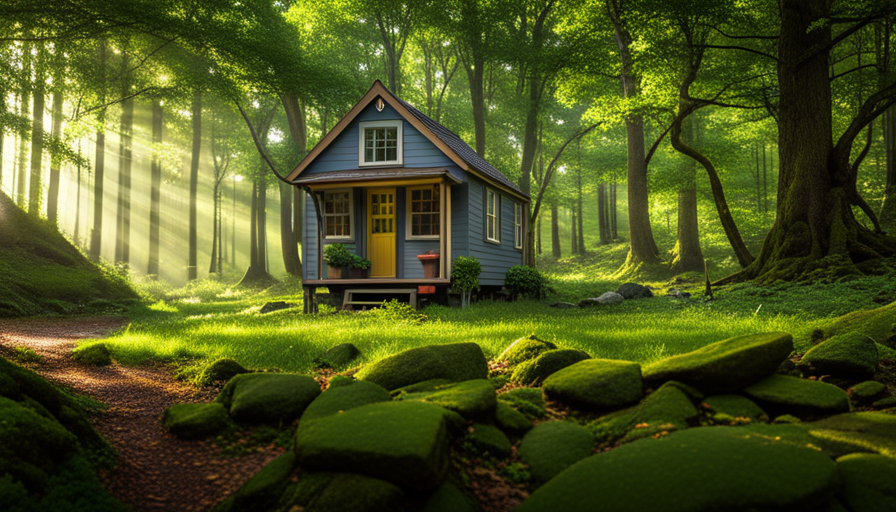
 Beginners Guides2 months ago
Beginners Guides2 months agoWhere To Park A Tiny House In New Jersey









